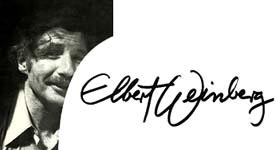 
CHRONOLOGY
From his parents, Weinberg
inherited his penchant for hard work. But his
artistic ambition was just an accident, he believes,
or perhaps the result of one. "It may all come down
to the fact that I hurt my eye when I was about
four," he theorizes. The eye was saved but his
vision was permanently impaired. He was left
with distorted depth perception, able to see
only impressions out of his right eye. Throughout
his childhood, there was great concern about
his ability to see.
Still, from the day he
picked up a crayon, he showed promise. "Copying Mickey Mouse and
Donald Duck on shirt cardboards - that was my
specialty. My father had his shirts laundered,
and they all came back on shirt cardboards. That
was my favorite medium." He traces the birth
of his predilection for sculpture to his three-dimensional
projects. He was always building soapbox derby
racers, burglar alarms, submarines.
But it was
his youthful passion to create that won his
parents over. When he was 14, he made a small
clay relief and accidentally broke it while
trying to cast it in plaster. It made him cry
desperately, his mother recalls. If it's that
important to him, she decided, he ought to
have lessons. So she called Henry Kreis, a
German sculptor living in Essex, Connecticut.
Kreis was teaching at the Hartford Art School
then housed in the Wadsworth Atheneum, and
he suggested that young El enroll. So he lied
about his age and studied there at night throughout
high school. It was a rigorous schedule, but
he surmounted it to become valedictorian of
his class at Weaver High in 1946... After graduating,
Weinberg enrolled at the art school full time
and continued to study with Kreis, whom he
idolized and to whom he credits his preference
for lyrical, figurative work. He was equally
devoted to Waldemar Raemisch, another German,
with whom be studied upon transferring to the
Rhode Island School of Design after two years. "He couldn't express himself in English," Weinberg
says. "He was just a tremendously inspirational
person-- his work and his love of art."
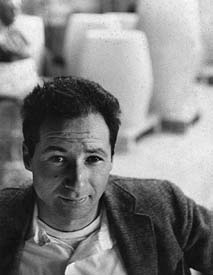 Under Raemisch he studied
hard, but it was a labor of love. "When I was in art school, I
had my own studio and boy, I worked." ...He worked
at a car wash, painted flowers on furniture,
taught arts and crafts at a boys' club. Meanwhile,
he slaved away in his studio, an abandoned bathroom
at the Volunteers of America, the home for derelicts
in which he lived his first year. "I paid $2
a week, and I lived on crackers and jelly given
by the Colonel, who ran the place. I lived with
all the down-and-out guys, and the Colonel --
I'll never forget him -- he kept us alive." Under Raemisch he studied
hard, but it was a labor of love. "When I was in art school, I
had my own studio and boy, I worked." ...He worked
at a car wash, painted flowers on furniture,
taught arts and crafts at a boys' club. Meanwhile,
he slaved away in his studio, an abandoned bathroom
at the Volunteers of America, the home for derelicts
in which he lived his first year. "I paid $2
a week, and I lived on crackers and jelly given
by the Colonel, who ran the place. I lived with
all the down-and-out guys, and the Colonel --
I'll never forget him -- he kept us alive."
Ultimately, all this diligence
and deprivation paid off. After graduating at 23,
Weinberg became the youngest recipient to ever
have won the Prix de Rome, entitling him to two
years of study in Italy. There, he met poets, painters,
and musicians, and discovered that, for an artist,
Europe is not just an ocean away but a world apart. "You get up
in the morning and you go out
and greet your friends. In America,
they say, 'How's business? How much did you
make this month?' Whereas in Europe they ask
you what you're making or what you're doing.
They don't ask you how much you sold this year.
Art is business here, and that's not what it's
all about."
Upon returning
home, he underwent not only cultural
jet lag but future shock. He
had accepted a scholarship at
Yale School of Design, which
involved assisting the master
sculptor, José de
Rivera, an abstract purist whose work was based
on precise, mathematical concepts. The head of
the school was Josef Albers, the famed German-born
abstractionist best known for his series of paintings "Homage
to the Square." It was Albers who had summoned
Weinberg from Rome. "Come back and teach the
figure," he had written. "Even though I don't
believe in the figure, I think it should be
taught in my school."
Weinberg complied,
only to be stylistically ostracized
and denounced by the dictatorial
Albers in front of his students. "The prevailing mode
in the sculpture department was a certain kind
of pure abstraction. I did not fit in. And I
could not adapt. It wasn't my way." But try he
did, for three years. He felt it was an inevitable
confrontation. "It was like 'How to Live with
the 20th Century' -- a decompression chamber.
How to co-exist. How to learn to take from
it without letting it upset me..."
|
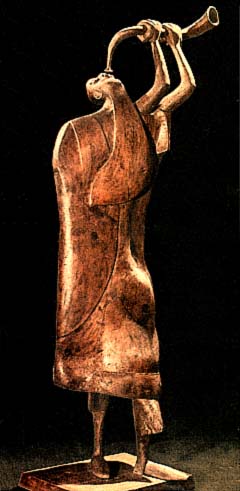
"Ritual Figure," Museum of Modern
Art |
While living in Rome,
he had been given his first commission by a visiting
couple from his hometown, Marcus and Bluma Bassevich.
Weinberg had it on display in his living room at
Yale, where it was spied by a visiting trustee
of the Museum of Modern Art. "Ritual Figure", a
woodcarving of a man blowing a shofar, was an unusual
piece, but not for Weinberg; it had two arms growing
out of one shoulder. "When they said they'd buy
it, I remember rushing through the streets into
my friend's house, running up to a girl I knew
and saying, "I've got to kiss someone." And she
was offended. "You mean, just anyone? It doesn't
matter who it is?"
"Ritual Figure" made the cover of Art in America. Soon
after, Weinberg got a knock on his door..."I hear
you sold something to the Museum of Modern Art.
I'm interested in you. "I just thought he was a
great sculptor," said Grace Borgenicht [of the
Borgenicht Gallery in New York City.] "I go by
my eye and I guess it's pretty good, because I've
stayed in business for 37 years."
Borgenicht remembers calling Joseph Hirshhorn,
founder of the Hirshhorn Museum in Washington,
D.C., on behalf of a struggling client. "I said,
'Joe, there's this terrific sculptor. He doesn't
have any money to buy a piece of wood.'
So Joe gave me the money to give him to buy
the wood, and then he did a beautiful woodcarving
which they bought and put in the museum." |
In 1959 Weinberg landed a Guggenheim
Fellowship, a grant for a year of work. He decided
to return to Rome for the year and ended up staying
for 11. "It was a paradise for sculptors. They
love artists. Whether you're good or not, they
call you Maestro. 'Buon giorno, Maestro!' It's
a wonderful feeling..."
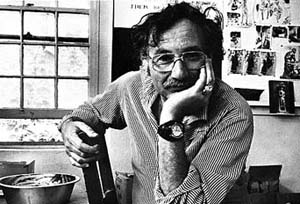
Returning to America, he taught
at Dartmouth and Boston University as visiting
Professor of Sculpture, then back in Rome at
Temple University, at Union College in New
York, and finally, starting in 1983, as Professor
of Sculpture at Boston University.
Among the major public commissions
Weinberg completed during this time were: Procession for
the Jewish Museum in New York, Jacob Wrestling
with the Angel for Brandeis University, Justice for
the Boston University School of Law, and the Holocaust
Memorial for Freedom Plaza in Wilmington,
Delaware.
In 1986, John Portman, an acclaimed
architect known for introducing the atrium
to contemporary hotel design, turned to Weinberg
to humanize the 18-story lobby of his Portman
Hotel San Francisco [now Pan Pacific Hotel.]
"Elbert has a unique way of
giving life to form, where the piece carries
with it an aura that's very special," Portman
said. He's a very warm person, and I think
it comes out in his sculpture." Weinberg's
exuberant Joie
de Danse not only illustrates his skill
in gearing a piece to complement a specific
environment, Portman believes. It is also an
exceptional, compelling work. "It just grabs
you.' he says. "Just to observe people looking
at it and see the response on their faces tells
the whole thing ... He's one of the best."
Weinberg's early subjects draw
heavily on mythological and Biblical themes,
but there are also more contemporary, earthbound
motifs, such as his mad
dog series. "...People might say, 'Oh my
God, what a thing to try to do in sculpture!'" notes
Weinberg. 'An idea like that.'" He is the first
to acknowledge that these fierce beasts are
unsettling, but bristles at a suggestion that
they may not be what people want in their living
rooms: "This is not art for all," he
thunders. "What does this have to do with the
average person? Most people don't understand
art," he declares, "any more than they understand
Greek. "Art is a language, like any other language.
You have to be exposed to it, you have to learn
it. The average person, without that training,
likes things that look like reality." He poses
one hand before him. "If you saw my hand in
wood or stone, the average person would say
'fantastic!' And it would be a piece of trash!"
As a figurative sculptor, Weinberg doesn't reject reality,
but often departs from it radically to offer his own
interpretation. |
Weinberg used to work
on one piece at a time. First, he would make
a series of drawings. Then, on one special day,
when he was feeling at his best, he would sit
down and fashion a model. Once satisfied, he
would spend nine months making the piece--carving
it in wood or casting
it in bronze. Then he would start another."Now
I'm working on 20 pieces at the same time," he
says. "And I'm enjoying working more than I ever
have in my life."
After years of exercising
his imagination, he has honed his mental muscles
into tiptop shape. Even the craft part comes
easier now. "There's something about having
done it for so many years that you get familiar
with the process. It's more like talking. It's
part of you...I feel anything I conceive, I
can make," he says. "I am whistling and hopping
here in the studio now. I mean, it can be painful
when a thing doesn't come out right. But I'm
getting kicks all the time." |
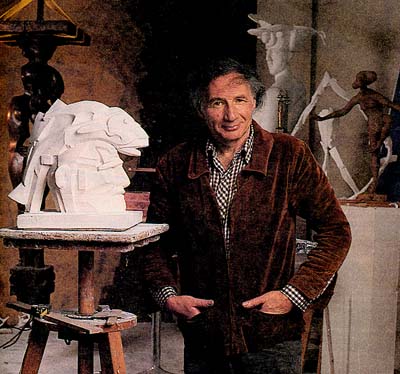
Natural
History III  The
Hartford Courant, March 20, 1988 The
Hartford Courant, March 20, 1988
|
 --Adapted
from article in The Hartford Courant Northeast
Magazine, March 20, 1988, by Patricia Weiss. --Adapted
from article in The Hartford Courant Northeast
Magazine, March 20, 1988, by Patricia Weiss.
Elbert Weinberg died in
December of 1991 of myelofibrosis, a rare disease
of the bone marrow that was diagnosed ten years
earlier. The Elbert Weinberg Trust has been established
to preserve his work and to ensure that the work
of this sculptor of genius continues to receive
the recognition it deserves. All works shown here,
except public commissions, are for sale. Each is
marked as limited edition, open edition, or one-of-a-kind
original.
|
|

